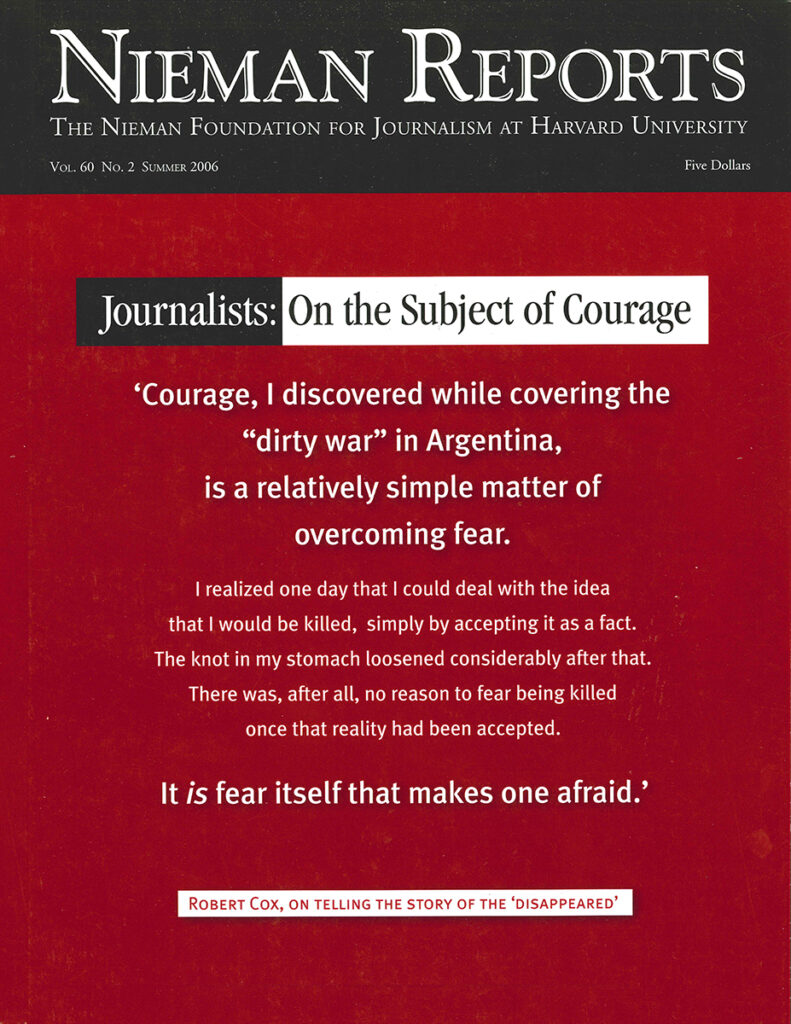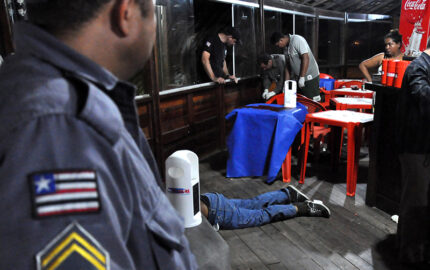
Journalists: On the Subject of Courage
Courage, as these journalists remind us, exposes itself in different guises. It can be found in the wisdom of understanding when danger finally has outweighed the risk. Or it can surface when threats to personal safety lurk but the lessons of training combine with inner strength to push fear aside and persevere. Courage can reside, too, in a journalist's isolation when editorial stands taken shake the foundation of friendship and sever long-held ties to one's community. In this issue, glimpses of such journalistic courage are offered.
Buford Boone's years as an FBI agent introduced him to fear, but nothing like he felt when he climbed the stairs inside the Tuscaloosa courthouse in January 1957 to face a seething, racist mob of white men and women. Boone — who had returned to his first career, newspapers, and become editor and publisher of The Tuscaloosa News — had taken a strong and overwhelmingly unpopular stand that the University of Alabama ought to enroll and protect its first black student, Autherine Lucy. And he had decried the thugs who swarmed on campus and tried to attack her as she headed toward classes.
Now he was about to encounter the West Alabama Citizens' Council, which had enough clout to gain use of a courtroom for their meeting. He had been invited to explain his position. Then he had been uninvited — out of concern that he would be physically attacked.
He went anyway. In spite of the hissing and jeering, he started talking. "It is not the easiest speaking assignment I ever have accepted," he said."But I believe the problem of segregation and integration is one that needs to be discussed rationally, fully and intelligently."
He added, "I believe the Supreme Court decision had to come and was morally right." The mocking continued, accompanied by a threat to throw him out the window. But he kept talking. "Nothing in it is inconsistent with my conception of democracy ...."
Risks Worth Taking
Boone, who held his own and survived the night, was one of a small group of liberal and moderate Southern editors, probably no more than 20 at any one time, who risked the anger of their readers as well as circulation and advertiser boycotts to urge compliance with the Supreme Court's school desegregation decisions of 1954 and 1955. Reporters and photographers, too, braved mobs, bottles, bricks and gunfire to report on the civil rights struggle. They painted a picture of white supremacist and segregationist excesses that American voters, ultimately, could not ignore.
Many editors were not even integrationists, or didn't start out that way. They urged little more than compliance with the law. But they paid a heavy price even for that stand. During the Central High School desegregation crisis in Little Rock in 1957, Harry Ashmore and J.N. Heiskell, editor and owner of the Arkansas Gazette, editorialized, sometimes on the front page, that the national interest must prevail over regionalism and that the Supreme Court must be obeyed to avert anarchy. Their newspaper suffered severe circulation drops and lost an amount equivalent to $13 million today. But they didn't alter their views a bit.
The owners of the main black newspaper in town, the Arkansas State Press, lost even more. In 1950, when Ebony magazine asked black editors to write the headline they most wanted to see in their newspapers, L.C. and Daisy Bates wrote the most ambitious of them all: "South Abolishes All Jim Crow." They wrote their newspaper — and in her advocate's role, Daisy ran the local NAACP and led the nine black students who integrated Central High School — with the same gutsy ambition. They remained bold even as their national advertising base disappeared. They kept the paper on life support until 1959, when it finally gave out and died.
Some editors responded fearlessly to brutality. L. Alex Wilson was highly respected and influential in the black community and among white politicians and professionals in Memphis, where he was editor of the Tri-State Defender, a black weekly. But on the streets of Little Rock, where he and three other black journalists walked toward Central High, the lanky, impeccably dressed editor was treated with the indignity of a slave. Surrounded by a scrum of angry white men, he was taunted, slapped and pushed to the ground. He rose, quietly retrieved his hat, and tried to walk forward when he was kicked repeatedly from behind. Then a man leapt onto his back, put him in a stranglehold and smashed him on the head.
Wilson's revenge came in his refusal to break. He picked himself up every time he was knocked down, he recreased his hat every time it was crumpled, and he walked without assistance to his car. Through it all, he kept the middle button of his suit coat fastened. But he was never the same after that. He suffered physical aftershocks that contributed to his death three years later at age 51.
In north Mississippi, Hazel Brannon Smith watched the financial health of the Lexington Advertiser decline precipitously after she protested the sheriff's shooting of a black man for making too much noise. The boycotts against her paper increased in intensity when she editorially attacked the white Citizens' Council. Her husband was fired from his job as a hospital administrator. She didn't back down.
Ira Harkey, Jr., editor and publisher of the Pascagoula Chronicle in Mississippi, became a pariah in his town. His offense? He opposed Governor Ross Barnett's stop-at-nothing approach to preventing the desegregation of the University of Mississippi. A bullet pierced the door of his newspaper. A shotgun blasted out a window of his home. A cross was burned on his lawn. "Ah, autumn!" Harkey wrote. "Falling leaves ... the smell of burning crosses in the air...."
The Power of Words
Humor often proved to be the only antidote and best bond among the dissident editors. Two of the most courageous were father and son, Hodding Carter, Jr. and Hodding Carter III of The Delta Democrat-Times in Greenville, Mississippi. They never lost their ability to laugh or their sense of outrage at racial injustice, particularly the organized brand published by the Citizens' Councils.
When a local jury took 24 minutes to ignore all evidence and acquit a sheriff of murder in the death of a black inmate, Hodding Carter, Jr. spoofed the prevailing sentiment among whites: "What with all these nosey newspapermen and preachers and Yankees and other such communistic trash, it's getting to where a Mississippi white man can't kill himself a nigguh without getting his name in the papers and losing up to two or three days in court. Downright subversive, we call it, and something ought to be done. Otherwise, what was the use of us winning the war for Southern independence?"
After Carter wrote an article for Look magazine detailing the menacing spread of the Citizens' Councils, the article was branded on the floor of the Mississippi House of Representatives "a willful lie [by] a nigger loving editor." The House censured Carter.
Carter's front-page editorial response was a classic. "By a vote of 89 to 19 the Mississippi House of Representatives has resolved the editor of this newspaper into a liar because of an article I wrote .... If this charge were true it would make me well qualified to serve with that body. It is not true. So to even things up I herewith resolve by a vote of 1 to 0 that there are 89 liars in the State Legislature .... I am hopeful that this fever like the Ku Kluxism which rose from the same kind of infection, will run its course before too long a time. Meanwhile those 89 character mobbers can go to hell collectively or singly and wait there until I back down. They needn't plan on returning."
When it became popular among racists to refer to Atlanta Constitution editor Ralph McGill as "Rastus Ralph," McGill fought back. He named his little dog Rastus and trained it to bark whenever a telephone receiver was pointed at it. Thereafter, when he received harassing telephone calls at home, McGill would say, "So you want to speak to Rastus," and point the receiver at the dog. The dog would bark away.
Reporters, frequently dispatched to cover stories in unsafe outposts of hostile people, were under constant threat. French reporter Paul Guihard was shot to death on the University of Mississippi campus in 1962; others were attacked, some viciously, as they moved from Southern dateline to Southern dateline. Claude Sitton of The New York Times and Karl Fleming of Newsweek, who set the standard for reporters covering the movement, learned to operate strategically for survival. They saw that if they took a steno pad, cut it in two and put one in the inside breast pocket of their suit coat, it couldn't be seen by the mobs. And if they put both inside the pocket, the mobs might think they were hiding a shoulder holster and mistake them for FBI agents.
There may never have been a time in our nation's history when more journalistic courage was shown than in the civil rights era of the 1950's, 60's and 70's. The presence of Southern editors willing to display dissent against rising mob madness emboldened national leaders — presidents, congresses, religious figures, corporate executives and, especially, black civil rights leaders — to press for change. The bravery of reporters and photographers drove them to penetrate the South to see firsthand — and, more importantly, to show — the raw grip of white supremacy on an entire region of the country.
The journalistic boldness, in turn, made the nation more courageous as it spoke up against injustice and transformed civil rights from a movement to a national imperative.
Gene Roberts, a 1962 Nieman Fellow, is a journalism professor at the University of Maryland and the former editor of The Philadelphia Inquirer and former managing editor of The New York Times. Hank Klibanoff is managing editor for news of The Atlanta Journal-Constitution. Their book, "The Race Beat: The Press, the Civil Rights Struggle, and the Awakening of a Nation," will be published in the fall by Alfred A. Knopf.
Now he was about to encounter the West Alabama Citizens' Council, which had enough clout to gain use of a courtroom for their meeting. He had been invited to explain his position. Then he had been uninvited — out of concern that he would be physically attacked.
He went anyway. In spite of the hissing and jeering, he started talking. "It is not the easiest speaking assignment I ever have accepted," he said."But I believe the problem of segregation and integration is one that needs to be discussed rationally, fully and intelligently."
He added, "I believe the Supreme Court decision had to come and was morally right." The mocking continued, accompanied by a threat to throw him out the window. But he kept talking. "Nothing in it is inconsistent with my conception of democracy ...."
Risks Worth Taking
Boone, who held his own and survived the night, was one of a small group of liberal and moderate Southern editors, probably no more than 20 at any one time, who risked the anger of their readers as well as circulation and advertiser boycotts to urge compliance with the Supreme Court's school desegregation decisions of 1954 and 1955. Reporters and photographers, too, braved mobs, bottles, bricks and gunfire to report on the civil rights struggle. They painted a picture of white supremacist and segregationist excesses that American voters, ultimately, could not ignore.
Many editors were not even integrationists, or didn't start out that way. They urged little more than compliance with the law. But they paid a heavy price even for that stand. During the Central High School desegregation crisis in Little Rock in 1957, Harry Ashmore and J.N. Heiskell, editor and owner of the Arkansas Gazette, editorialized, sometimes on the front page, that the national interest must prevail over regionalism and that the Supreme Court must be obeyed to avert anarchy. Their newspaper suffered severe circulation drops and lost an amount equivalent to $13 million today. But they didn't alter their views a bit.
The owners of the main black newspaper in town, the Arkansas State Press, lost even more. In 1950, when Ebony magazine asked black editors to write the headline they most wanted to see in their newspapers, L.C. and Daisy Bates wrote the most ambitious of them all: "South Abolishes All Jim Crow." They wrote their newspaper — and in her advocate's role, Daisy ran the local NAACP and led the nine black students who integrated Central High School — with the same gutsy ambition. They remained bold even as their national advertising base disappeared. They kept the paper on life support until 1959, when it finally gave out and died.
Some editors responded fearlessly to brutality. L. Alex Wilson was highly respected and influential in the black community and among white politicians and professionals in Memphis, where he was editor of the Tri-State Defender, a black weekly. But on the streets of Little Rock, where he and three other black journalists walked toward Central High, the lanky, impeccably dressed editor was treated with the indignity of a slave. Surrounded by a scrum of angry white men, he was taunted, slapped and pushed to the ground. He rose, quietly retrieved his hat, and tried to walk forward when he was kicked repeatedly from behind. Then a man leapt onto his back, put him in a stranglehold and smashed him on the head.
Wilson's revenge came in his refusal to break. He picked himself up every time he was knocked down, he recreased his hat every time it was crumpled, and he walked without assistance to his car. Through it all, he kept the middle button of his suit coat fastened. But he was never the same after that. He suffered physical aftershocks that contributed to his death three years later at age 51.
In north Mississippi, Hazel Brannon Smith watched the financial health of the Lexington Advertiser decline precipitously after she protested the sheriff's shooting of a black man for making too much noise. The boycotts against her paper increased in intensity when she editorially attacked the white Citizens' Council. Her husband was fired from his job as a hospital administrator. She didn't back down.
Ira Harkey, Jr., editor and publisher of the Pascagoula Chronicle in Mississippi, became a pariah in his town. His offense? He opposed Governor Ross Barnett's stop-at-nothing approach to preventing the desegregation of the University of Mississippi. A bullet pierced the door of his newspaper. A shotgun blasted out a window of his home. A cross was burned on his lawn. "Ah, autumn!" Harkey wrote. "Falling leaves ... the smell of burning crosses in the air...."
The Power of Words
Humor often proved to be the only antidote and best bond among the dissident editors. Two of the most courageous were father and son, Hodding Carter, Jr. and Hodding Carter III of The Delta Democrat-Times in Greenville, Mississippi. They never lost their ability to laugh or their sense of outrage at racial injustice, particularly the organized brand published by the Citizens' Councils.
When a local jury took 24 minutes to ignore all evidence and acquit a sheriff of murder in the death of a black inmate, Hodding Carter, Jr. spoofed the prevailing sentiment among whites: "What with all these nosey newspapermen and preachers and Yankees and other such communistic trash, it's getting to where a Mississippi white man can't kill himself a nigguh without getting his name in the papers and losing up to two or three days in court. Downright subversive, we call it, and something ought to be done. Otherwise, what was the use of us winning the war for Southern independence?"
After Carter wrote an article for Look magazine detailing the menacing spread of the Citizens' Councils, the article was branded on the floor of the Mississippi House of Representatives "a willful lie [by] a nigger loving editor." The House censured Carter.
Carter's front-page editorial response was a classic. "By a vote of 89 to 19 the Mississippi House of Representatives has resolved the editor of this newspaper into a liar because of an article I wrote .... If this charge were true it would make me well qualified to serve with that body. It is not true. So to even things up I herewith resolve by a vote of 1 to 0 that there are 89 liars in the State Legislature .... I am hopeful that this fever like the Ku Kluxism which rose from the same kind of infection, will run its course before too long a time. Meanwhile those 89 character mobbers can go to hell collectively or singly and wait there until I back down. They needn't plan on returning."
When it became popular among racists to refer to Atlanta Constitution editor Ralph McGill as "Rastus Ralph," McGill fought back. He named his little dog Rastus and trained it to bark whenever a telephone receiver was pointed at it. Thereafter, when he received harassing telephone calls at home, McGill would say, "So you want to speak to Rastus," and point the receiver at the dog. The dog would bark away.
Reporters, frequently dispatched to cover stories in unsafe outposts of hostile people, were under constant threat. French reporter Paul Guihard was shot to death on the University of Mississippi campus in 1962; others were attacked, some viciously, as they moved from Southern dateline to Southern dateline. Claude Sitton of The New York Times and Karl Fleming of Newsweek, who set the standard for reporters covering the movement, learned to operate strategically for survival. They saw that if they took a steno pad, cut it in two and put one in the inside breast pocket of their suit coat, it couldn't be seen by the mobs. And if they put both inside the pocket, the mobs might think they were hiding a shoulder holster and mistake them for FBI agents.
There may never have been a time in our nation's history when more journalistic courage was shown than in the civil rights era of the 1950's, 60's and 70's. The presence of Southern editors willing to display dissent against rising mob madness emboldened national leaders — presidents, congresses, religious figures, corporate executives and, especially, black civil rights leaders — to press for change. The bravery of reporters and photographers drove them to penetrate the South to see firsthand — and, more importantly, to show — the raw grip of white supremacy on an entire region of the country.
The journalistic boldness, in turn, made the nation more courageous as it spoke up against injustice and transformed civil rights from a movement to a national imperative.
Gene Roberts, a 1962 Nieman Fellow, is a journalism professor at the University of Maryland and the former editor of The Philadelphia Inquirer and former managing editor of The New York Times. Hank Klibanoff is managing editor for news of The Atlanta Journal-Constitution. Their book, "The Race Beat: The Press, the Civil Rights Struggle, and the Awakening of a Nation," will be published in the fall by Alfred A. Knopf.


